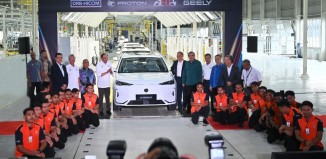A Day at the BMW Driver Training Course
You are cruising along a nice quiet country road enjoying the drive. The air is clear and fresh as it had rained earlier but the road has already dried and you move at a brisk pace. A sharp corner appears and you slow down slightly. As the car sweeps through the curve, the tyres hit a slippery patch where some mud was washed down from the slopes. The rear wheels lose their grip and the rear end slides out, a condition called ‘oversteer’.
For many people, oversteer is frightening and with no knowledge of what to do, they cannot bring their car under control and go off the road into a drain or hit another car. Braking definitely doesn’t help and will make things worse.
Surviving such a situation is what the BMW Driver Training Course at the Sepang International Circuit (SIC) aims to teach motorists to be able to do. The day-long RM700 course offered by Auto Bavaria is based on BMW’s Driver Training Course in Munich, Germany, and in the words of Rajan Thurairatnam, Auto Bavaria’s GM, “the training starts where regular driving schools end”.
Mr Rajan explained that BMW Driver Training teaches the participants to appreciate and understand the limits of technology and driving skill, allowing them at the same time to assess and overcome potential hazards, in particular by avoiding such risks from the start.
“The course covers several fundamental aspects of safe driving. These include correct seating position, vehicle handling, cornering forces, understeer, oversteer, correct braking and so on,” he said. “It is not to teach people to become racing drivers.”
A unique feature at the school is that the students don’t have to use their own cars so they don’t have to worry about wear and tear or damage. Auto Bavaria supplies 328i sedans specially imported for the purpose.
At present, there are four local instructors – David MacGuhan, Keith Nunis, Shahjahan and Ringo Chong – who have undergone training in Germany. According to Mr Rajan, there are plans to increase the number of instructors to cope with the greater number of courses planned in 2001. For the remaining months of this year, only ten courses will be held for Malaysian BMW owners (non-owners may have a chance to apply at a later stage).
AUTOWORLD.COM.MY’s Chips Yap was invited to take part in an inaugural course for members of the media and this is his report:
“BMW’s Driver Training is not new to me as, over the years, I have attended a few of the courses in Malaysia and Germany. As with the other courses, the emphasis is on driving and the theory part presented in one of the air-conditioned suites over the paddock at SIC was only about an hour. It was intended to be 45 minutes but with my usually curious mind, additional time was needed to discuss some points!
In being trained, the students are taught to Recognise, Avoid and Resolve a potentially dangerous situation. These come through practice but in order to recognise the danger, it is necessary to experience it, hence the emphasis on driving exercises. The same goes for avoidance, which is recommended, but if the danger cannot be avoided, then the correct way to resolve it is crucial.
But well before all that, the students need to know how to sit and hold the steering wheel and that is covered in the theory session. For many, it is perhaps necessary to ‘unlearn’ what seems to be the wrong way of doing such things. There are those who may have arms extended straight, assuming it is the ‘cool look’ but straight arms do not allow good leverage to turn the steering wheel. The shoulders should also be pressed against the backrest for better support during manoeuvres.
Likewise, the legs should be slightly bent for two reasons. One is to be able to exert maximum force on the brake pedal and the other is to reduce the risk of breaking your hipbone in a frontal collision. A bent leg will prevent direct transmission of the shock to the upper body.
Holding the steering wheel correctly is also another major lesson. The correct way is to have the left hand at the 9 o’clock position and the right hand on the 3 o’clock position. When turning right, grip firmly and rotate the steering wheel with the left hand as far towards the right as needed. Same thing for turning left.
It is important never to cross the arms over as this will create problems when you have to make sudden turns. This is very important at high speeds where the amount of turning will be not great but the need for quick reactions is. However, at very low speeds, eg in car parks, you can cross the hands over as this will provide better leverage.
The other major thing discussed is the dynamics of a car in motion and the various forces that act on it. As the contact patches under each tyre are the only contacts between the car and the road, understanding them and how they change in different conditions is very important. That’s why pressures need to be right and to be checked regularly and the tyres should have enough tread on them for proper grip on wet surfaces.
The most eye-opening discussion is on braking. The instructor showed us charts which indicated braking distances and the various phases from the time a danger is spotted to the moment the car stops moving. Although you may think that braking distance is measured from the time of pressing the brake, it is actually from the time you realise the danger – and this can be as long as three-quarters of a second for the average driver. At even 30 km/h, that already means you have gone about 6.2 metres… even before your brain starts telling your foot to press the brake pedal. By the time your car does stop, it will already have covered at least 12.7 metres on a dry surface.
That 0.75 of a second lost in perceiving the danger and reacting becomes even more significant as the speed becomes higher: at 50 km/h, you would move 10 metres – about 33 feet – before braking even commences. And the total braking distance is not 1.6 times greater than 30 km/h – it is double the distance! That’s the reason why built-up areas, especially near schools, have speed limits of 30 km/h or less and why you should observe them.
The use of electronic aids like ABS has enabled braking to become more effective but there are no electronic aids to improve the human body’s reactions so it is necessary to be sensible about the speeds you drive at.
“You should know your own limits – which are different from driver to driver – and drive within them,” recommends BMW instructor Ringo Chong, who is also a racing driver. He adds that ‘discipline is extremely important to safe driving’.

























